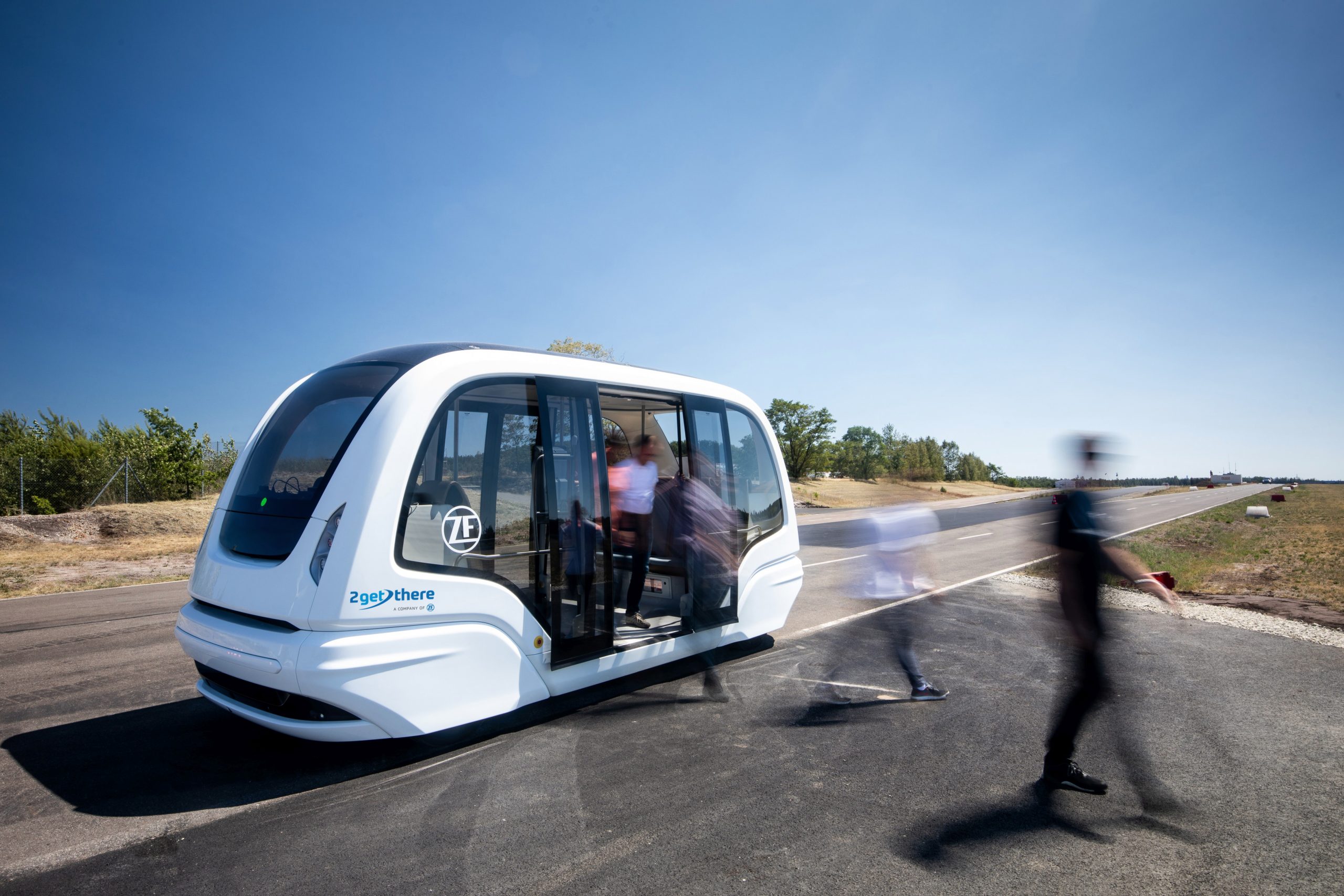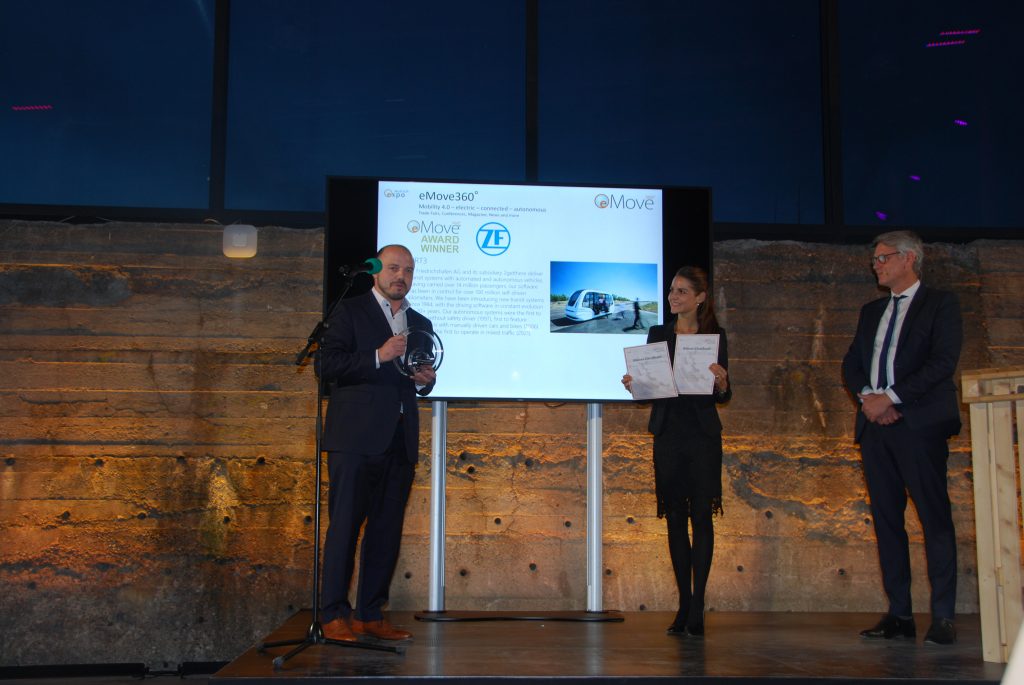 Autonome Shuttles wie die des ZF-Unternehmens 2getthere werden künftig noch viel stärker den Verkehr entlasten.
//
Autonomous shuttles such as those of the ZF company 2getthere will relieve traffic even more in the future.
Autonome Shuttles wie die des ZF-Unternehmens 2getthere werden künftig noch viel stärker den Verkehr entlasten.
//
Autonomous shuttles such as those of the ZF company 2getthere will relieve traffic even more in the future.
The expert jury of the eMove360° Award for electromobility & autonomous driving had nominated the most innovative and promising submissions for mobility. In the category Autonomous Vehicle, the jurors selected ZF Friedrichshafen AG as the winner. ZF Friedrichshafen AG and its subsidiary 2getthere deliver transit systems with automated and autonomous vehicles. Having carried over 14 million passengers, their software has been in control for over 100 million self-driven kilometers. They have been introducing new transit systems since 1984, with the driving software in constant evolution for 20+ years. Their autonomous systems were the first to operate without safety driver (1997), first to feature intersections with manually driven cars and bikes (2006) and will be the first to operate in mixed traffic (2021).

The Pionier in autonmous transports
ZF Friedrichshafen AG and its subsidiary 2getthere deliver permanent, driverless and stewardless automated transport systems to the market today. With over 100 million self-driven kilometers in real operation and more than 14 million passengers transported, ZF and 2getthere have the most experience in autonomous driving. The key to being able to do this is the focus on delivering a driverless system rather than (just) driverless vehicles, to focus on transit needs, while ensuring that they leading in technology and vehicle functionality.
By using a system approach, ZF/2getthere are able to work with authorities in the current absence of a standard that covers all aspects of assessing the safety of an autonomous, mixed operations application. To support the system approach, all developments and deliveries are based on the system life cycle approach. This process is used for each application, with the V-model being applied to verify the design and the requirements via testing on every level.
Partner of Brussels Airport and Rivium
For Rivium (Transdev) and Brussels Airport (De Lijn) the reason to select 2getthere as the partner for the delivery and support of operations, was the ability to deliver against the requirements, provide long term support and being economically attractive based on Total Costs of Ownership. The transit system supplements existing transit networks, with our offering comparing favourably to the competition – for the cases under contract, our offering was half the cost compared to the next closest bidder.
The system approach requires ZF/2getthere to focus on the transit needs to define the requirements of an application. They are not ‘pushing technology’ to the market, but are assessing whether the requirements and needs of the application and the desires of our customer match with the transit solutions and technology we have to offer – while still providing an economically sensible business case.
Operations on segregated infrastructure, dedicated lanes or in mixed traffic
ZF/2getthere enable operations on a segregated infrastructure, dedicated lanes or in mixed traffic. In some applications featuring all spatial integrations within a single application. The type of spatial integration is dependent on the requirements of the application and the desires of the customer. For instance, when needing a very high capacity (such as 5,000 people per direction per hour), mixed traffic is less sensible when there is already a lot of traffic on the existing roads. The transit system would add to that further, without providing added value to its passengers and thus making it less attractive to use. With less passenger, and passengers willing to pay less for the trip, the business case for such application could also be difficult.
TOMS: Transit Operations Monitoring and Supervision
An essential part of being able to provide a system lies in our supervisory system TOMS: Transit Operations Monitoring and Supervision. The supervisory system is an essential element of any automated system. TOMS (supervisor software) and FORCES (vehicle software) go hand-in-hand to provide the full functionality required for autonomous driving. TOMS is currently in its third generation and enables deadlock-free route planning, order management & dispatching, fleet traffic control and transit optimization by: Routes mapped with real world coordinates, including an e-horizon – User interfaces: passengers, stations, vehicles, control rooms and administrators – APIs for integration with intelligent transportation systems (ITS) and mobility as a service apps (MaaS) – Safety controls
In addition to TOMS, 2getthere also has a patented localisation technology based on artificial reference points that we can offer to our customers, with distinct advantages: Robust in all weather conditions – High availability (>99.7%) and reliability (99.9%) – No costs for updates, negligible costs for installation –Invisible – High accuracy in positioning (<2.5 centimeters) and driving (<10cm at 80kph)
Software FORCES
2getthere’s FORCES software is agnostic to the localisation technology used. As such, we can also support operations based on detection of natural landmarks and/or GNSS with the availability in the Service Level Agreement (SLA) having to be adjusted accordingly. When new localisation methods become more mature and robust enough, we can integrate them on our vehicle and with our FORCES software. Ultimately, our autonomous vehicle is the piece de resistance of unique value proposition. It provides a larger capacity, which was a requirement set by transit operating company Connexxion (part of Transdev). The occupancy of 22 passengers, in combination with a operating speed of 40kph, means we need less vehicles to achieve the required hourly capacity.
Unique 3rd generation GRT
The 3rd generation GRT (Group Rapid Transit) vehicle is unique in being the only bi-directional vehicle in the market with doors on both sides. As such integration in the local spatial planning while providing optimal accessibility at stations is ensured. The battery technology used allows for opportunity charging at 5C (184 kW). This allows charging while docking at stations, avoiding the need to take vehicles off-line to recharge. The advantage is not only minimization of the fleet to provide continuous operations throughout a 16-hour (or longer) day, but also avoiding the need for a large depot to store vehicles while charging. When maintaining a state-of-charge between 30% and 80% throughout the day, the expected battery life exceeds 7 years.
The passenger comfort is ensured through air suspension and braking takes into account the maximum jerk-parameters set. The GRT vehicle was developed based on the requirements of the hot Middle-East climates, featuring an air-conditioning system developed together with NLR (the Dutch Space Agency) and DC Airco (manufacturer of the air conditioning system). Despite the large glass surfaces we are able to provide an agreeable temperature in the passenger cabin.
The vehicle features large glass surfaces to create an attractive look-and-feel, while also ensuring visibility of the passengers in light of the social safety (without driver the chances of passengers being harassed are related to the ability to see for everybody what is happening in the vehicle). To improve aesthetics further, we also covered the wheels and purposely decided to integrate sensory systems in the design. In addition to looking more pleasing, this also makes them less vulnerable. It has been designed based on the system approach and focus on permanent projects. The design life of the vehicles is 20 years.
www.zf.com; www.2getthere.eu